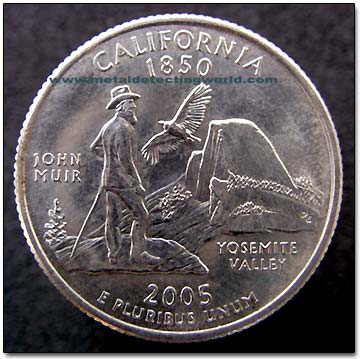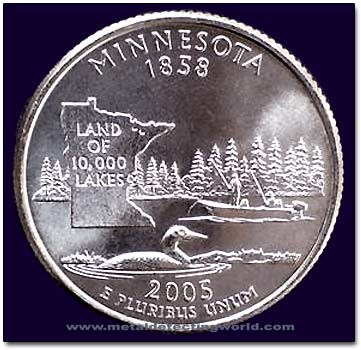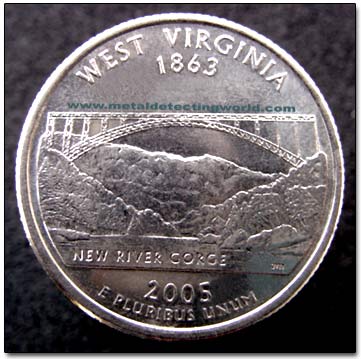US Statehood Quarters of 2005:
California, Minnesota, Oregon, Kansas, West Virginia
Numismatic and Historic Info, Images
Coins' Specifics:
Diameter:
24.3 mm
Weight: 5.67 grams
Edge: Reeded
Composition: outer layers of copper-nickel (.750 copper, .250 nickel) bonded to
inner core of pure copper
Quantity minted:
Mints: Philadelphia, Denver,
San Francisco
CALIFORNIA STATE QUARTER
California was admitted into the Union on September 9, 1850, becoming the Nation’s 31st State. Nicknamed the "Golden State," California’s quarter depicts naturalist and conservationist John Muir admiring Yosemite Valley’s monolithic granite headwall known as "Half Dome" and also features the California condor in a tribute to the successful repopulation of the once nearly extinct bird. The coin bears the inscriptions "California," "John Muir," "Yosemite Valley" and "1850."

In 1849, the year before California gained statehood, the family of 11-year-old John Muir emigrated from Scotland to the United States, settling in Wisconsin. In 1868, at the age of 30, Muir sailed up the West Coast and landed in San Francisco. He made his home in the Yosemite Valley, describing the Sierra Nevada Mountains as "the Range of Light… the most divinely beautiful of all the mountain chains I have seen." He devoted the rest of his life to the conservation of natural beauty, publishing more than 300 articles and 10 books that expanded his naturalist philosophy. In 1890, Congress established Yosemite National Park, and in 1892 John Muir helped form the Sierra Club to protect it, serving as that organization’s President until his death in 1914.
Release Date: January 31, 2005
Statehood Date: September 09, 1850
Mintage Numbers: 520,400,000
MINNESOTA STATE QUARTER
On May 11, 1858, Minnesota became the 32nd state admitted into the Union. The design features a tree-lined lake with two people fishing, a loon on the water, and a textured outline of the State surrounding its nickname, "Land of 10,000 Lakes."

The "Land of 10,000 Lakes" actually contains more than 15,000 lakes whose total shoreline exceeds 90,000 miles - more than California, Hawaii and Florida combined. Equally renowned as the home of the headwaters of the mighty Mississippi River, the name Minnesota is derived from the Dakota Sioux word for "cloudy water."
Release Date: April 04, 2005
Statehood Date: May 11, 1858
Mintage Numbers: 488,000,000
OREGON STATE QUARTER
On February 14, 1859, Oregon became the 33rd state to be admitted into the Union. Its coin design features a portion of Crater Lake, the deepest lake in the United States, viewed from the south-southwest rim. The design incorporates Wizard Island, as well as Watchman and Hillman Peaks on the lake’s rim and conifers. The coin bears the inscription "Crater Lake."

Crater Lake is a unique and stunning natural treasure, formed more than 7,700 years ago by the collapse of Mt. Mazama in what is now southern Oregon. At 1,949 feet, it is the deepest lake in the United States and the seventh deepest in the world, and has a record clarity depth of 134 feet. The main cause of Crater Lake’s remarkable clarity is its isolation from incoming streams and rivers.
President Theodore Roosevelt established Crater Lake National Park in 1902, with the lake itself as the Park’s crown jewel. It is the sixth oldest national park in the country. Since its creation, Crater Lake National Park has helped protect both the Native American cultural ties to the area and the natural habitat of the animal and plant life that lies within its boundaries.
Release Date: June 06, 2005
Statehood Date: February 14, 1859
Mintage Numbers: 720,200,000
KANSAS STATE QUARTER
On January 29, 1861, the "Sunflower State" became the 34th state to be admitted into the Union. The design features a buffalo and sunflower motif, emblematic of the State’s history and natural beauty.

Each of two design elements is a visual reminder of the Nation’s heartland. They feature prominently in the history of the territory, and both were found in abundance throughout the State in the middle of the 19th century when Kansas gained its statehood. With its release in the Fall of 2005, it is the second United States circulating coin of 2005 to carry an image of the buffalo.
Release Date: August 29, 2005
Statehood Date: January 29, 1861
Mintage Numbers: 563,400,000
WEST VIRGINIA STATE QUARTER
On June 20, 1863, the "Mountain State" became the 35th state to be admitted into the Union. The design captures the scenic beauty of the State with the New River Gorge Bridge, the engineering wonder. The coin bears the inscription "New River Gorge."

Prior to gaining statehood, the area that is now West Virginia formed the western part of Virginia. Settlers in the western part of the "Old Dominion" began their efforts to join the federal Union when Virginia announced its secession in 1861. In the western part of the State, the Restored Government of Virginia in Wheeling drafted a state constitution in 1862. The new state called West Virginia applied to Congress for admission into the Union. Congress approved the request with one condition, that the new state abolish slavery. President Lincoln signed the West Virginia statehood bill and on June 20, 1863, West Virginia officially became the 35th state to be admitted into the Union.
At 3,030 feet long and 69 feet wide, the New River Gorge Bridge is the world’s largest steel span and the second highest bridge in the United States, rising 876 feet above the New River Gorge in southern West Virginia. The completion of the bridge in 1977 reduced this dangerous 40-minute trip to a smooth and scenic one-minute drive. In 1978, 53 miles of the New River was added to the National Park System as the New River Gorge National River.
Release Date: October 14, 2005
Statehood Date: June 20, 1863
Mintage Numbers: 721,600,000
Total of state quarters minted in 2005: 3,013,600,000
Year of issuance: